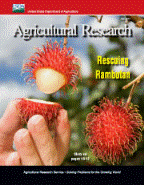United States Department of Agriculture: Agricultural Research Service, Lincoln, Nebraska

Agricultural Research Magazine
Date of this Version
7-2013
Document Type
Article
Citation
Agricultural Research July 2013.
Abstract
Native juniper trees and invasive plants pose an expanding threat to the survival of the sagebrush ecosystem in arid western rangelands. As the trees mature, they compete with other native plants that are valuable food sources for wildlife and cattle. After these plants die back, the bare patches of soil that remain are vulnerable to erosion and encroachment from other species like cheatgrass, an invasive nonnative annual that fuels wildfires.
Wildfires threaten livestock ranches, are suppressed in large part by efforts funded with taxpayer dollars, and increase the probability that invasive plants will spread and thrive in the postfire landscape. So while western juniper, pinyon pine, and other similar native trees have a role to play in this ecosystem, the thickets that are rapidly spreading across the rangelands need to be brought under control.
Fortunately, the challenge these trees present to healthy rangelands also creates an opportunity for using them as a feedstock for renewable jet fuel production. And this new opportunity means that western states could significantly contribute to meeting national goals for the production of renewable bioenergy in the United States—and help the U.S. military develop homegrown and sustainable sources of alternative biofuels for powering its assortment of vehicles, planes, and ships.
Agricultural Research Service researchers already have a framework in place for tackling the many issues that need to be resolved before turning a tree into a gallon of renewable fuel. In 2010, U.S. Department of Agriculture Secretary Tom Vilsack created five Regional Biomass Research Centers to maximize existing USDA research resources for bioenergy development. The goal of this effort is to develop sustainable, regional approaches for producing feedstocks so that rural communities across the country have opportunities to participate in the emerging biofuels and biobased-products economy. (See “ARS and the Regional Biomass Research Centers,” Agricultural Research, September 2012.)
Included in
Agriculture Commons, Animal Sciences Commons, Food Science Commons, Plant Sciences Commons

